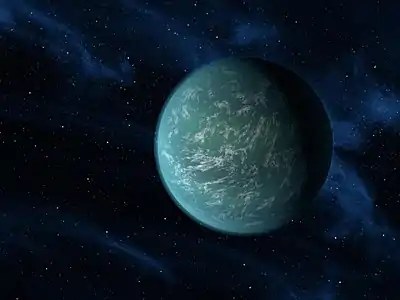(415029) 2011 UL21
(415029) 2011 UL21, provisional designation 2011 UL21, is an Apollo class potentially hazardous asteroid discovered on October 17, 2011 by the Catalina Sky Survey project.[1] The asteroid is estimated to have a diameter of 2.5 kilometres (1.6 mi). It was rated at Torino Scale 1 on October 27, 2011 with an observation arc of 9.6 days.[4]
| Discovery[1] | |
|---|---|
| Discovered by | Catalina Sky Srvy. |
| Discovery site | Catalina Stn. |
| Discovery date | 17 October 2011 |
| Designations | |
| (415029) 2011 UL21 | |
| 2011 UL21 | |
| Apollo · NEO · PHA [2] | |
| Orbital characteristics[2] | |
| Epoch 13 January 2016 (JD 2457400.5) | |
| Uncertainty parameter 0 | |
| Observation arc | 9379 days (25.68 yr) |
| Aphelion | 3.5091 AU (524.95 Gm) |
| Perihelion | 0.73606 AU (110.113 Gm) |
| 2.1226 AU (317.54 Gm) | |
| Eccentricity | 0.65323 |
| 3.09 yr (1129.5 d) | |
| 110.19° | |
| 0° 19m 7.392s / day | |
| Inclination | 34.845° |
| 275.60° | |
| 284.74° | |
| Earth MOID | 0.0185982 AU (2.78225 Gm) |
| Physical characteristics | |
Mean diameter | 2.5 km[3] |
| Mass | 2.1×1013 kg (assumed)[3] |
| 15.8[2] | |
Description
2011 UL21 briefly had about a 1 in a million chance of impacting in 2029.[5] Its cumulative impact probability dropped to 1 in 71 million by 2 November 2011 when the observation arc reached 15 days. It was removed from the Sentry Risk Table on 4 November 2011 when all impact scenarios for the next 100 years or more were ruled out.[6] During 2029, the closest approach to Earth is 1.6 AU. Palomar Observatory precovery images from 1989 and 1990 have extended the observation arc to 22 years.[7] Its next notable close approach to the Earth will be on June 27, 2024 at a distance of 0.044 AU (6,600,000 km; 4,100,000 mi).[8]
With an absolute magnitude of 15.8,[2] it is one the brightest and therefore largest potentially hazardous asteroids (PHA) detected since (242450) 2004 QY2.[9] The next largest PHA (based on absolute magnitude) discovered in 2011 is 2011 WO41 with an absolute magnitude of 16.8.[9]
| PHA | Date | Approach distance in lunar distances | Abs. mag (H) |
Diameter (C) (m) |
Ref (D) | ||
|---|---|---|---|---|---|---|---|
| Nominal (B) | Minimum | Maximum | |||||
| (143651) 2003 QO104 | 1981-05-18 | 2.761 | 2.760 | 2.761 | 16.0 | 1333–4306 | data |
| 2014 LJ21 | 1989-08-01 | 7.034 | 6.843 | 7.224 | 16.0 | 1333–4306 | data |
| 4179 Toutatis | 1992-12-08 | 9.399 | 9.399 | 9.399 | 15.30 | 2440–2450 | data |
| 4179 Toutatis | 2004-09-29 | 4.031 | 4.031 | 4.031 | 15.30 | 2440–2450 | data |
| (159857) 2004 LJ1 | 2038-11-16 | 7.719 | 7.719 | 7.719 | 15.4 | 1746–4394 | data |
| (4953) 1990 MU | 2058-06-05 | 8.986 | 8.984 | 8.988 | 14.1 | 3199–10329 | data |
| 4179 Toutatis | 2069-11-05 | 7.725 | 7.724 | 7.725 | 15.30 | 2440–2450 | data |
| (52768) 1998 OR2 | 2079-04-16 | 4.611 | 4.611 | 4.612 | 15.8 | 1462–4721 | data |
| (415029) 2011 UL21 | 2089-06-25 | 6.936 | 6.935 | 6.938 | 15.7 | 1531–4944 | data |
| 3200 Phaethon | 2093-12-14 | 7.714 | 7.709 | 7.718 | 14.6 | 4900–5300 | data |
| (52768) 1998 OR2 | 2127-04-16 | 6.536 | 6.510 | 6.563 | 15.8 | 1462–4721 | data |
| (A) This list includes near-Earth approaches of less than 10 lunar distances (LD) of objects with H brighter than 16. (B) Nominal geocentric distance from the center of Earth to the center of the object (Earth has a radius of approximately 6,400 km). (C) Diameter: estimated, theoretical mean-diameter based on H and albedo range between X and Y. (D) Reference: data source from the JPL SBDB, with AU converted into LD (1 AU≈390 LD) (E) Color codes: unobserved at close approach observed during close approach upcoming approaches | |||||||
References
- "MPEC 2011-U39 : 2011 UL21". IAU Minor Planet Center. 28 October 2011. Retrieved 1 November 2011.
- "JPL Small-Body Database Browser: (2011 UL21)". Jet Propulsion Laboratory. Retrieved 8 April 2016.
2012-04-18 last obs (arc=22 years)
- "Earth Impact Risk Summary: 2011 UL21". NASA/JPL Near-Earth Object Program Office. Retrieved 1 November 2011. (Wayback Machine)
- "Observations of small Solar-System bodies". hohmanntransfer. 27 October 2011. Retrieved 4 September 2013. (1.5e-06 = 1 in 667,000 chance)
- David Morrison (26 October 2011). "Should we be concerned about 2011 UL21". NASA Ask An Astrobiologist. Retrieved 6 November 2011.
- "Date/Time Removed". NASA/JPL Near-Earth Object Program Office. Retrieved 6 November 2011.
- "2011 UL21 Orbit". Minor Planet Center. Retrieved 17 May 2012.
2012 04 18 (arc=22 years)
- "JPL Close-Approach Data: (2011 UL21)". Retrieved 17 May 2012.
2012-04-18 last obs (arc=22 years)
- "JPL Small-Body Database Search Engine: PHAs and H < 17 (mag)". JPL Solar System Dynamics. Retrieved 20 November 2011.
External links
- (415029) 2011 UL21 at NeoDyS-2, Near Earth Objects—Dynamic Site
- Ephemeris · Obs prediction · Orbital info · MOID · Proper elements · Obs info · Close · Physical info · NEOCC
- (415029) 2011 UL21 at ESA–space situational awareness
- (415029) 2011 UL21 at the JPL Small-Body Database



.jpg.webp)